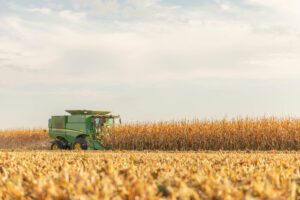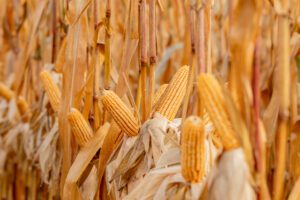YIELD DATA ACCURACY
 An increasing reliance upon yield monitor data to evaluate crop performance and inform management decisions has placed greater importance on ensuring yield data quality.
An increasing reliance upon yield monitor data to evaluate crop performance and inform management decisions has placed greater importance on ensuring yield data quality.
Yield monitors are capable of providing very accurate estimates of corn yield; however, real-world performance can fall well short of this potential due to lack of proper calibration and other sources of error.
The following guidelines, adapted from Yield Monitor Systems (Darr, 2016), can help maximize yield monitor accuracy in on-farm trials.
MASS FLOW SENSOR
The mass flow sensor must be calibrated to ensure accurate yield data. In general, the mass flow sensor should be recalibrated anytime there is a significant change in crop conditions. These include the following conditions:
- After a long period of inactivity such as at the beginning of a new season.
- Switching between crop types.
- Significant changes in crop moisture of more than 4%.
- Significant test weight changes.
- Changes in crop conditions that cause a shift in operating speeds including lodged or downed crops, high moisture crops, or significant changes in ground conditions.
Calibration Procedure: Specific calibration procedures vary depending on the manufacturer, but several general recommendations fit all brands:
- Calibrate for at least the minimum number of loads recommended by the yield monitor manufacturer.
- Each calibration load should be at least 3,000 lbs; greater than 5,000 lbs is preferred.
- Calibration loads should be taken as a single pass, when possible, to avoid errors associated with grain flow delay.
- Each calibration load should be conducted at a different mass flow rate. This can be controlled either by slowing down the maximum speed of the combine or by maintaining a set speed and reducing the active header width.
- The calibration flow rates should cover the entire range of flow rates that are expected in the target crop.
- After calibration, you can use “regions” or “loads” to monitor the accuracy of the calibration.
MOISTURE SENSOR
The moisture sensor should also be recalibrated periodically or when there is a significant change in crop conditions.
Calibration Procedure: Specific calibration procedures vary depending on the manufacturer, but several general recommendations fit all brands:
- Start a new combine load. This will create a new log that can be used to calibrate the grain moisture.
- Harvest an entire grain tank of grain.
- Stop the harvester and randomly sample the grain tank from several locations.
- Record the load moisture from the yield monitor.
- Calculate the actual moisture content of the grain tank sample using an accurate moisture tester. Handheld moisture meters are generally not accurate enough for this measurement unless it has been calibrated against a higher accuracy meter. To reduce errors, record three separate moisture readings from the single grain sample and use the average as the actual moisture.
- Enter the difference between the actual moisture and the yield monitor load moisture as a moisture offset.
Temperature calibration requires a similar offset adjustment. Make sure to calibrate temperature when the combine is not operating and has been in a constant shaded environment for a couple of hours.
BEST MANAGEMENT PRACTICES FOR TEST PLOTS
 While yield monitors can be excellent tools for field scale evaluation, care must be taken when using these same tools for small scale comparisons such as test plot strips. The following steps will help to improve yield monitor performance in short test strips, but well calibrated weigh wagons are still recommended for greater accuracy.
While yield monitors can be excellent tools for field scale evaluation, care must be taken when using these same tools for small scale comparisons such as test plot strips. The following steps will help to improve yield monitor performance in short test strips, but well calibrated weigh wagons are still recommended for greater accuracy.
- Operate at normal combine speed. Test plots are often shorter rows which can lead to operators slowing down. The mass flow sensor is calibrated for normal crop flow, so to maintain accuracy the test plot should be conducted under the same conditions.
- Conduct rolling starts. To get the combine up to steady state grain flow as quickly as possible make sure the combine is moving at a normal speed when first engaging the crop. This is known as a rolling start.
- Be wary of significant moisture differences. If the test plot has significant grain moisture differences (more than 5% differences) then hand samples of the plots should be collected to verify the moisture content. For every 1% error in grain moisture the yield calculation will be off by 2.5 bu/acre.
- Avoid changing terrain. If the test plot field has rolling terrain you should harvest all plots in the same direction. This will reduce the impact of field slope on yield data errors.
Maintain an accurate header width. When harvesting a test plot with a platform header be sure to maintain a consistent cutting width throughout the plot.
INTERPRETING YIELD DATA
Properly calibrating the yield monitor and following best management practices for harvesting test plots can help improve the accuracy of yield monitor data, but a useful interpretation of the data requires an understanding of how other environmental and management factors may have impacted yield. Even with a properly calibrated yield monitor, there can be substantial differences in yield potential between fields and areas within a field that can confound yield results when evaluating performance of products and management practices. To get a better understanding of how soils, weather, planting date, and other factors impact yield, use a software solution such as Granular Insights, along with your trusted advisor, to analyze operation, field, and subfield level data.
REFERENCES
Darr, M. 2016. Yield Monitor Systems. Iowa State University Ames, IA.
Jeschke, M. 2017. Yield Monitor Data for Management Decisions
Written by Mark Jeschke, Ph.D., Corteva Agriscience Agronomy Manager
The foregoing is provided for informational use only. Please contact your sales professional for information and suggestions specific to your operation. Product performance is variable and depends on many factors such as moisture and heat stress, soil type, management practices and environmental stress as well as disease and pest pressures. Individual results may vary. Corteva brand products are provided subject to the terms and conditions of purchase which are part of the labeling and purchase documents.